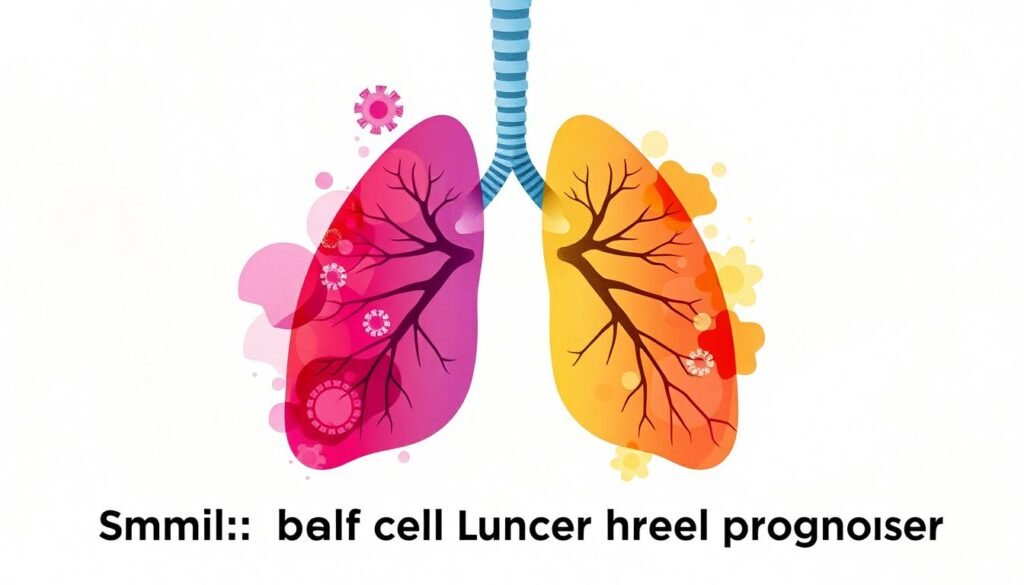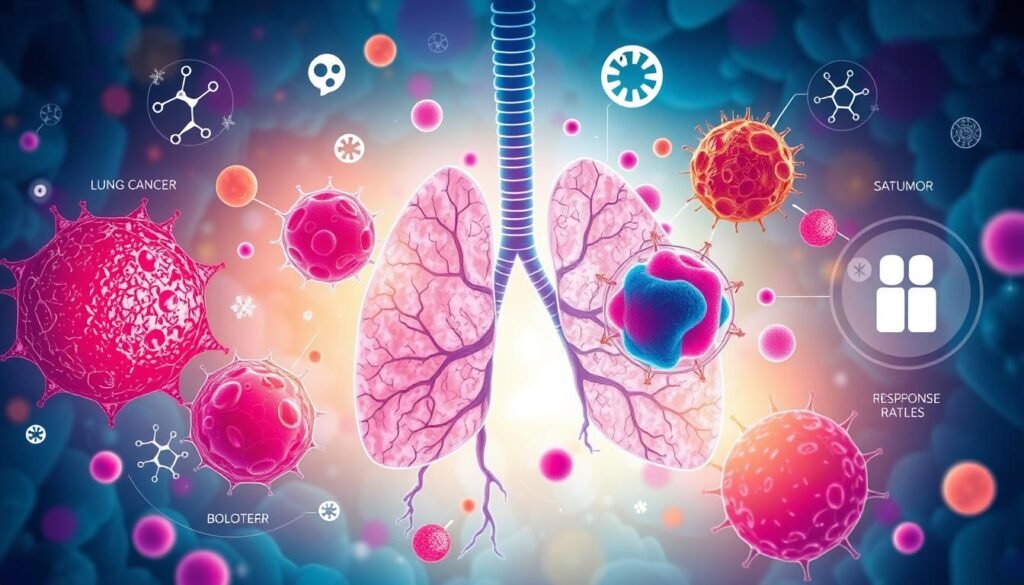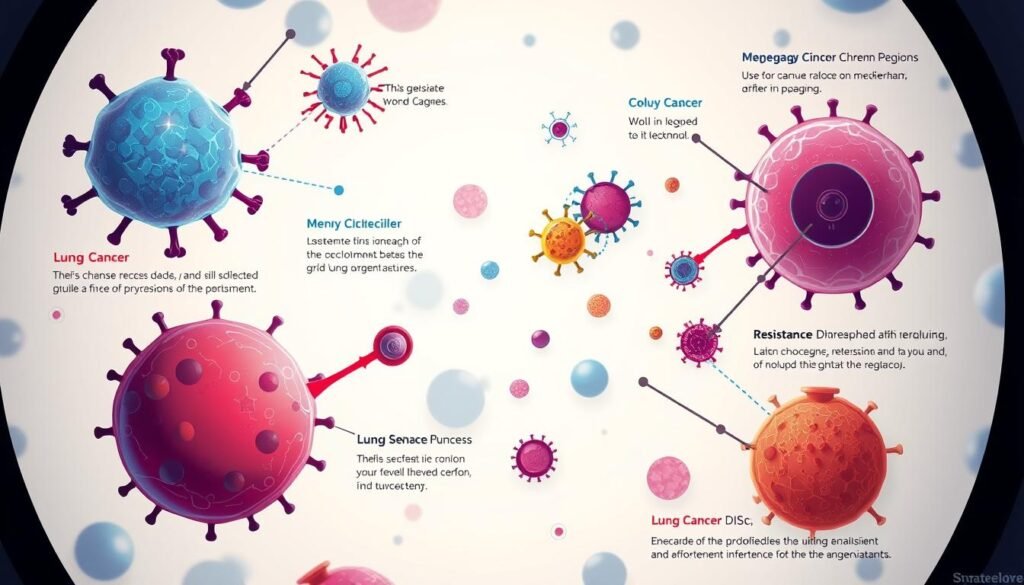More than half of lung cancer patients pass away within a year of finding out they’re sick. This sad fact shows how crucial it is to know how well treatments work. Especially chemotherapy for different kinds of lung cancer. Lung cancer is a top cause of death from cancer worldwide. There are two main kinds: small cell lung cancer (SCLC) and non-small cell lung cancer (NSCLC).
In this article, we’re looking into how well chemotherapy works for both types of lung cancer. We’ll see why knowing the patient’s prognosis is so important for choosing treatment. By learning about how effective chemotherapy is and the results for patients, you’ll understand more about lung cancer treatments. You’ll also learn how the stage of cancer affects chances of survival. This info aims to improve your knowledge of lung cancer treatment results.
Key Takeaways
- Lung cancer accounts for a significant number of cancer-related deaths each year.
- There are critical distinctions between SCLC and NSCLC in terms of treatment and survival rates.
- Success rates of chemotherapy vary significantly based on the stage of cancer.
- Understanding the patient’s health condition is vital in determining chemotherapy effectiveness.
- Research continues to unveil data on treatment response and long-term survival.
Understanding Lung Cancer Types
Lung cancer is mainly in two types: small-cell lung cancer (SCLC) and non-small-cell lung cancer (NSCLC). Each type is different in how it behaves, how it is treated, and its outcome. Knowing about these Lung Cancer Types helps us understand the hurdles in diagnosing and treating them.
Definitions and Subtypes
Small-cell lung cancer makes up 10% to 15% of all lung cancers. It spreads quickly and is very aggressive. On the other hand, non-small-cell lung cancer is about 80% to 85% of all lung cancer. It is divided into several subtypes:
- Adenocarcinoma: This is the most common type of NSCLC, found in both smokers and non-smokers.
- Squamous Cell Carcinoma: Mostly seen in smokers, it’s found in the central parts of the lungs.
- Large Cell Carcinoma: Known for its fast growth and ability to spread quickly, it includes a subtype related to SCLC.
Prevalence of Small Cell and Non-Small Cell Lung Cancer
Understanding the prevalence of these cancers is crucial. NSCLC makes up nearly 90% of lung cancer cases. Out of these, adenocarcinoma is the most common, being 30% of all lung cancer diagnoses. SCLC, though less common and comprising fewer than 20% of cases, is challenging to treat due to rapid metastasis.
Risk Factors for Lung Cancer Development
Several factors contribute to the risk of developing SCLC and NSCLC. The top cause of lung cancer deaths is cigarette smoking, accounting for over 80% of cases. Other important risk factors include:
- Radon exposure
- Air pollution
- Occupational hazards
- Genetic predispositions
Knowing these risk factors is key to preventing lung cancer and catching it early. For more details on the differences between small cell and non-small cell lung cancer, check out this comprehensive resource.
Overview of Chemotherapy in Lung Cancer Treatment
Chemotherapy is key in treating lung cancer. It aims to improve survival rates and ease disease symptoms. The goal is to attack cancer cells with drugs. This benefits patients with small and non-small cell lung cancer.
Purpose and Goals of Chemotherapy
The goals of chemotherapy are to shrink tumors, stop cancer from spreading, and better life quality. Doctors use different drugs together to get the best results. They also try to keep side effects low.
Types of Chemotherapy Drugs Used
Platinum-based drugs like cisplatin and carboplatin are common in chemotherapy. Each drug impacts how patients respond to treatment. Studies show cisplatin often works better than carboplatin.
Challenges and Considerations in Chemotherapy
Chemotherapy comes with challenges. Patients react differently to drugs, leading to issues like nausea. A tailored plan is essential, considering the patient’s health and cancer stage. Sometimes, it’s hard for patients to complete all chemotherapy cycles.
Success Rate of Chemotherapy for Small Cell vs Non-Small Cell Lung Cancer
The success rate of chemotherapy varies greatly between small cell lung cancer (SCLC) and non-small cell lung cancer (NSCLC). Knowing the differences is crucial in tailoring treatment plans. It also sets realistic expectations for lung cancer patients.
Comparison of Treatment Efficacy
Chemotherapy is vital for treating SCLC, achieving remission in about 80% of patients. But, the long-term survival rates tell a different story. Only 3.5% of SCLC patients reach a five-year survival mark. This underline SCLC’s aggressive nature.
In contrast, NSCLC patients experience better prospects, with a 65% chance of surviving five years. This shows the treatments for NSCLC are more effective.
Factors Affecting Success Rates
Several factors affect the success of chemotherapy for lung cancer. The stage of the tumor is crucial; SCLC usually is found at advanced stages. This worsens the outcomes. At diagnosis, 60 to 65% of SCLC patients are already in advanced stages.
SCLC’s complex biology, including fast tumor growth and early spreading, makes treatment difficult. On the other hand, NSCLC patients have better options like immunotherapy. These advances have led to higher response rates and better survival chances.
Factors like patient’s health, how far the cancer has spread, and differences in treatments play a big role. They greatly influence the effectiveness of chemotherapy for small cell versus non-small cell lung cancer.
Lung Cancer Treatment Outcomes
The success of lung cancer treatment varies based on the cancer type, treatment method, and the disease stage. Evaluating how patients react to treatments gives valuable insights. This helps doctors create better treatment plans.
Patient Response Rates and Survival Outcomes
Survival rates for lung cancer show why it’s crucial to treat early. Localized non-small cell lung cancer has a five-year survival rate of 65%. But, this rate falls to 37% at regional stages and 9% when cancer spreads. These numbers show the importance of detecting and treating lung cancer early.
Impact of Staging on Treatment Results
The stage of lung cancer greatly affects treatment success and future health. The TNM system is key for classifying lung cancer. It looks at tumor size, lymph node involvement, and if it has spread. The World Health Organization has made changes to improve this system. Understanding staging better leads to personalized treatments for patients. For more on lung cancer staging, visit this resource.
Chemotherapy Efficacy for Lung Cancer Types
The success of chemotherapy for lung cancer can vary a lot between types. Many clinical trials have shown differences in how patients respond based on the treatment and their specific situation.
Clinical Trials and Their Findings
Research from 124 studies with 171,757 people showed varying success of chemotherapy across lung cancer types. In advanced lung cancer, combining Targeted therapies reached a high response rate of 82.9%. Adding Immunotherapy to Chemo also had a strong response rate of 80.8%.
However, for non-advanced lung cancer, treatments like Chemoradio + Targeted had a lower response rate of 69.0%. This shows that the stage of cancer and the kind of treatment affects results.
| Treatment Type | Response Rate (Advanced Lung Cancer) | Response Rate (Non-Advanced Lung Cancer) |
|---|---|---|
| Targeted + Targeted | 82.9% | N/A |
| Chemo + Immuno | 80.8% | N/A |
| Chemoradio + Targeted | N/A | 69.0% |
| Chemoradio + Immuno | N/A | 67.8% |
| Chemoradio + Other Therapy | N/A | 60.7% |
Biomarkers and Personalized Treatment Options
Using biomarkers to test has changed how lung cancer is treated. Oncologists can now use these markers to pick the best chemotherapy for each patient.
This is especially good for those with non-small cell lung cancer (NSCLC). Studies show that choosing treatments based on biomarkers makes chemotherapy more effective and helps patients do better.
Small Cell Lung Cancer Prognosis
The prognosis for small cell lung cancer (SCLC) is a vital issue in cancer care. It is crucial to know the survival rates for this aggressive cancer. This helps patients and doctors make informed decisions.
Long-Term Survival Rates and Statistics
About 10-15% of all lung cancer cases are small cell lung cancer. This means roughly 31,000 people in the U.S. get diagnosed each year. Sadly, the 5-year survival rate for SCLC is under 7%. For early-stage diagnosis, survival goes up to about 27%. But, it drops to 3% when the cancer has spread. Most patients with SCLC live only a year or less. This highlights the urgent need for better treatments.
Factors Influencing Prognosis in SCLC Patients
Many factors affect the prognosis for SCLC patients. How well treatments work, other health issues, and genetic aspects are key. For example, mutations in the TP53 gene are common in 75% to 90% of cases. Also, 60% to 70% of patients have advanced disease when diagnosed. Researchers are working hard to find ways to improve survival rates. They focus on better treatment methods and care. For more details on this, check out key statistics on lung cancer.

Non-Small Cell Lung Cancer Prognosis
It’s crucial to understand the prognosis for Non-Small Cell Lung Cancer. This knowledge helps decide treatment paths and outcomes. The stage at diagnosis greatly impacts prognosis. Early detection means better chances of survival.
The Five-Year Survival Rates show how NSCLC Staging affects health. These rates vary by the cancer stage.
Five-Year Survival Rates for NSCLC
Survival Rates vary greatly for Non-Small Cell Lung Cancer based on the stage. If found early, the rate can be as high as 64%. This highlights the value of finding cancer early. As cancer grows, survival rates drop.
For regional cases, survival goes down to about 37%. And for cancer that has spread far, rates fall to around 8%. This shows why good screening and treatment are key.
Categorization Based on Staging
NSCLC Staging helps us understand how the disease progresses. It also helps tailor treatments. The main stages are:
- Stage 0: Cancer hasn’t spread beyond the airway lining.
- Stage 1: Tumors
- Stage 2: Tumors larger or with lymph node involvement on the same side.
- Stage 3: Tumors that have spread to central lymph nodes or are too large, possibly inoperable.
- Stage 4: Cancer has spread to other body parts.
Different stages impact prognosis greatly. They guide decisions on treatments from surgery to chemo and radiation.
Lung Cancer Chemotherapy Response Rates
An analysis of Lung Cancer Chemotherapy Response Rates reveals significant differences. These are based on cancer subtype and the patient’s background. Studies show response rates vary widely between individuals.
For example, limited stage Small Cell Lung Cancer (SCLC) often responds to chemotherapy 60% to 80% of the time. On the other hand, extensive stage SCLC typically shows over a 60% response rate with immunotherapy. This information is key to understanding how well various treatments work.
Meta-Analysis of Response Rates
Recently, studies have looked closely at different lung cancer response rates. They found the overall response rate to be 32.6%, affecting treatment choices. Limited stage SCLC patients getting platinum-based chemotherapy and etoposide may live 25 to 30 months.
This demonstrates the complex outcomes of treatment based on the chemotherapy used. The success rate for extensive stage SCLC with platinum-based therapy is around 10%. This shows the importance of reviewing treatment effectiveness regularly.
Influence of Patient Demographics on Response
The background of a patient plays a crucial role in how well chemotherapy works. Age, health, and initial health status are all important factors. They majorly affect treatment response.
This has led to a move towards personalized medicine. It lets doctors customize therapy for each individual’s unique traits and needs. Knowing these details can help improve treatment results greatly.

Comparative Survival Rates for Lung Cancer Subtypes
Understanding the different survival rates for lung cancer types is key. Studies show big survival differences between small cell lung cancer (SCLC) and non-small cell lung cancer (NSCLC). These differences highlight the role of early detection and new treatments in helping patients live longer.
Statistics from Recent Studies
Studies say the 5-year survival rate for NSCLC is about 65%. For SCLC, it’s only 7%. This shows the tough battle SCLC patients face. Sadly, only 15% of lung cancer cases are found early. Most, or 84%, are found when the cancer is advanced. The overall survival rate for NSCLC stands at 17.4%. This makes treatments like immunotherapy crucial for these patients.
Longitudinal Data Comparisons
Data over time shows good news; new treatments are helping patients live longer. The National Cancer Institute notes survival rates for NSCLC, which is 85% of cases, have risen thanks to targeted therapies. Survival rates for NSCLC subtypes, like adenocarcinoma, vary based on the treatment and patient.
Ongoing research is vital for improving lung cancer survival rates. It highlights the need for early detection and personalized treatment. For more info on lung cancer survival, click here to read an article from the National Center for Biotechnology Information.
Lung Cancer Chemotherapy Effectiveness
Understanding how effective lung cancer chemotherapy is means looking at different treatment plans. Studies show that using a mix of therapies works better than just one treatment. It’s vital to tailor treatments to each patient’s health and the specifics of their tumor to get the best results.
Assessing the Impact of Treatment Regimens
Recent research involved 2,714 patients in 16 studies. Of these, 1,399 patients got supportive care plus chemotherapy. They had better outcomes, with fewer deaths compared to those only receiving supportive care.
The numbers show chemotherapy makes a big difference. It boosted survival rates significantly one year after treatment. Survival went up from 20% to 29% with chemotherapy, a big improvement.
Role of Combination Therapies
For treating lung cancer, especially non-small cell lung cancer (NSCLC), using multiple therapies is key. Common plans include two chemotherapy drugs, combining cisplatin or carboplatin with others. This approach is crucial for early-stage cancer, lasting 3 to 4 months. In more advanced cases, treatment extends to 4 to 6 cycles.

Drugs like Cisplatin, Carboplatin, and Pemetrexed are often chosen. Their use highlights the importance of varied therapies in improving treatment outcomes for lung cancer.
Lung Cancer Treatment Success Factors
The success of treating lung cancer depends on many things. Most importantly, Patient Health is key to how well treatments work. If patients have other health issues, treatment may need adjustments. It’s important to check and improve a patient’s health before starting therapy.
Patient Health and Pre-existing Conditions
Healthy choices, like stopping smoking, boost treatment success. Knowing the lung cancer stage helps too. For example, early-stage non-small cell lung cancer (NSCLC) might just need surgery. But later stages could need more, like chemo and immunotherapy.
Healthcare System and Access to Treatment
How good the healthcare system is also affects treatment Access. Strong systems that catch the cancer early and educate patients lead to better choices. Patients with limited-stage small cell lung cancer (SCLC) who get fast care might see up to 70% response to chemo. Plus, having many treatment options, including targeted therapies, means care that fits the patient better and works well.
Conclusion
The success rate of chemotherapy for small cell vs non-small cell lung cancer shows how treatment works. Chemotherapy is mainly used for small cell lung cancer (SCLC). But, there’s more to learn about improving patient outcomes. For example, SCLC patients treated with radiation live about 12 months on average, with a 65.3% survival rate after a year. This shows why we need more research and new treatments to help more patients.
Recent studies offer hope with treatments that combine chemotherapy and radiotherapy. These combination treatments have seen tumor response rates hit 50% for total response and 23% for partial response. Also, survival rates have gone up over time. Early treatments had patients living 12 months, but more recent ones are up to 19 months. This indicates better care for patients over the years.
The hunt for personalized treatments and clinical trials is making strides, as seen in recent publications. Paying close attention to what each patient needs and new therapy options will likely lead to longer lives and better quality of life for those fighting lung cancer. As treatments get better, understanding the differences between SCLC and NSCLC becomes key to finding the best treatment plans.